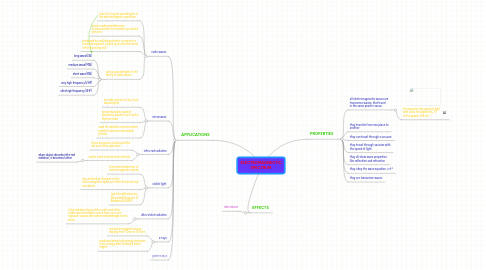
1. APPLICATIONS
1.1. radio waves
1.1.1. have the longest wavelenghts in the electromagnetic spectrum
1.1.2. used in radio and television communication to transmit sound and pictures
1.1.3. produced by oscillating electric currents in a transmitting aerial, picked up by another aerial at the recieving end
1.1.4. various wavelenghts in the family of radio waves
1.1.4.1. long wave(LW)
1.1.4.2. medium wave(MW)
1.1.4.3. short wave(SW)
1.1.4.4. very high frequency(VHF)
1.1.4.5. ultra high frequency(UHF)
1.2. microvaves
1.2.1. are radio waves of very short wavelenghts
1.2.2. are produced by special electronic devices such as the klystron tube
1.2.3. used for satellite communication, satellite television and mobile phones
1.3. infra-red radiation
1.3.1. these are waves just beyond the red end of the spectrum
1.3.2. can be used to treat various illness
1.3.2.1. when object absorbs infra-red radiation, it becomes hotter
1.4. visible light
1.4.1. the most familiarform of electromagnetics waves
1.4.2. also defined as that part of the electromagnetic spectrum that the human eye can detect
1.4.3. Light Amplification by Stimulated Emission of Radiation(LASER)
1.5. ultra-violet radiation
1.5.1. is the radiation beyond the violet and of the visible spectrum(main source from sun) over exposure causes skin cancer and damadge to the retina
1.6. x-rays
1.6.1. are electromagnetic waves ranging from 10nm to 10-4nm
1.6.2. produced when high energy electrons loose energy after striking a metal target
1.7. gamma rays
2. EFFECTS
2.1. skin cancer
3. PROPERTIES
3.1. all electromagnectic waves are transverse waves, that travel in the same peed in vacuo
3.1.1. this speed is the speed of light with value 3multiplied by 10 to the power of 8 ms-1
